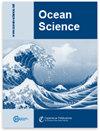利用模式识别技术改进海洋动态海平面变化的统计预估
IF 3.3
3区 地球科学
Q2 METEOROLOGY & ATMOSPHERIC SCIENCES
引用次数: 0
摘要
摘要基于统计关系的区域模拟工具,如模式标度,提供了一种计算成本较低的方法,可以预测大范围气候变化情景下的海洋动力海平面变化。这种方法通常需要仔细选择一个或多个气候变化预测变量,以便统计模型得到适当优化。即使选择了适当的预测因子,由内部气候变率驱动的时空振荡也可能是统计模式误差的一个重要来源。利用空间协方差信息的模式识别技术可以有效降低海洋动态海平面模拟的内部变异,显著降低区域模拟工具的随机误差。在这里,我们测试了两种基于经验正交函数(EOFs)的模式识别方法,即信噪最大化EOFs模式滤波和低频分量分析,以降低海洋动态海平面变化模式缩放的误差。我们使用马克斯普朗克研究所大系综(MPI-GE)作为两种方法的测试平台,因为它是一种初始条件大系综,设计用于最佳表征外部强迫响应。我们表明,在这里测试的两种方法比传统的方法(如简单的集合平均)更有效地减少了误差。例如,通过表征它们对外部强迫的共同响应来仅过滤两种实现,可以将随机误差降低近60%,这一降低只有通过平均至少12种实现才能实现。我们进一步研究了这两种方法在单实现建模实验中的适用性,包括四次cmip5模拟,与之前的区域模拟分析进行比较。模式过滤导致不同程度的误差减少,这取决于模型和场景,与未过滤的模拟相比,全球平均均方根误差减少了20%到70%。我们的研究结果强调了模式识别方法作为减少海洋动力海平面变化区域模拟工具误差的工具的相关性,特别是当一种或只有几种实现可用时。在调整区域模拟工具之前去除内部变异性可以优化统计模型的性能,导致模拟的动态海平面与未过滤的模拟相比存在实质性差异。本文章由计算机程序翻译,如有差异,请以英文原文为准。
Improving statistical projections of ocean dynamic sea-level change using pattern recognition techniques
Abstract. Regional emulation tools based on statistical relationships, such as pattern scaling, provide a computationally inexpensive way of projecting ocean
dynamic sea-level change for a broad range of climate change scenarios. Such approaches usually require a careful selection of one or more predictor
variables of climate change so that the statistical model is properly optimized. Even when appropriate predictors have been selected, spatiotemporal
oscillations driven by internal climate variability can be a large source of statistical model error. Using pattern recognition techniques that
exploit spatial covariance information can effectively reduce internal variability in simulations of ocean dynamic sea level, significantly reducing
random errors in regional emulation tools. Here, we test two pattern recognition methods based on empirical orthogonal functions (EOFs), namely
signal-to-noise maximizing EOF pattern filtering and low-frequency component analysis, for their ability to reduce errors in pattern scaling of
ocean dynamic sea-level change. We use the Max Planck Institute Grand Ensemble (MPI-GE) as a test bed for both methods, as it is a type of
initial-condition large ensemble designed for an optimal characterization of the externally forced response. We show that the two methods tested
here more efficiently reduce errors than conventional approaches such as a simple ensemble average. For instance, filtering only two realizations by
characterizing their common response to external forcing reduces the random error by almost 60 %, a reduction that is only achieved by averaging
at least 12 realizations. We further investigate the applicability of both methods to single-realization modeling experiments, including four CMIP5
simulations for comparison with previous regional emulation analyses. Pattern filtering leads to a varying degree of error reduction depending on
the model and scenario, ranging from more than 20 % to about 70 % reduction in global-mean root mean squared error compared with unfiltered
simulations. Our results highlight the relevance of pattern recognition methods as a tool to reduce errors in regional emulation tools of ocean
dynamic sea-level change, especially when one or only a few realizations are available. Removing internal variability prior to tuning regional
emulation tools can optimize the performance of the statistical model, leading to substantial differences in emulated dynamic sea level compared to
unfiltered simulations.
求助全文
通过发布文献求助,成功后即可免费获取论文全文。
去求助
来源期刊

Ocean Science
地学-海洋学
CiteScore
5.90
自引率
6.20%
发文量
78
审稿时长
6-12 weeks
期刊介绍:
Ocean Science (OS) is a not-for-profit international open-access scientific journal dedicated to the publication and discussion of research articles, short communications, and review papers on all aspects of ocean science: experimental, theoretical, and laboratory. The primary objective is to publish a very high-quality scientific journal with free Internet-based access for researchers and other interested people throughout the world.
Electronic submission of articles is used to keep publication costs to a minimum. The costs will be covered by a moderate per-page charge paid by the authors. The peer-review process also makes use of the Internet. It includes an 8-week online discussion period with the original submitted manuscript and all comments. If accepted, the final revised paper will be published online.
Ocean Science covers the following fields: ocean physics (i.e. ocean structure, circulation, tides, and internal waves); ocean chemistry; biological oceanography; air–sea interactions; ocean models – physical, chemical, biological, and biochemical; coastal and shelf edge processes; paleooceanography.
 求助内容:
求助内容: 应助结果提醒方式:
应助结果提醒方式:


